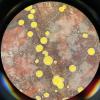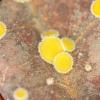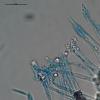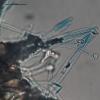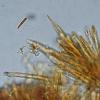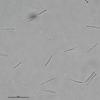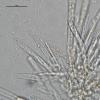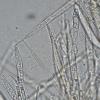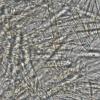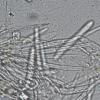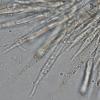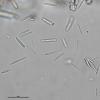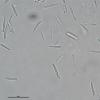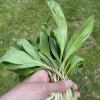
20-12-2025 23:08
Patrice TANCHAUDBonsoir, récolte sur sol sablonneux dans l'arri�

21-12-2025 09:32
Hello.A tiny ascomycete found embedded in wood in

20-12-2025 15:47
Mirek GrycHi.These grew on pine wood that was heavily covere

18-12-2025 21:17
Pol DebaenstThe identification took me to Byssonectria deformi

15-12-2025 07:09
 Danny Newman
Danny Newman
indet. Rutstroemiaceae sp. on unk. fallen leavesMc

19-12-2025 10:10
Patrice TANCHAUDBonjour, récolte réalisée en milieu dunaire, a

18-12-2025 17:23
 Bruno Coué
Bruno Coué
Bonjour,je serais heureux d'avoir votre avis sur c
Lachnaceae
Guy Buddy,
05-05-2020 01:05
This fruit on old Quercus leaves is really common in Pennsylvania, USA. Measuring ~2mm when hydrated, it has a small stipe with dense hairs covering entire ascocarp. Hairs ~ 100-120 um completely covered in warts to tip, septate, and with crystals at tips that dissolve in KOH but remain in H2O and lactophenol blue. Paraphyses lanceolate and stick out a bit further then asci. Spore measure in H20:(10.4) 10.7 – 34.4 (43.5) × (1.4) 1.5 – 5.8 (6.7) µm;Q = (4) 4.6 – 9.1 (10.3) ; N = 25; Me = 21.7 × 3.6 µm; Qe = 6.5
I’ve been searching for Lachnum or Incrucipulum with spore size, paraphyses, and hairs with Barals Lachnaceae & Arachnopezizaceae but can’t find anything that fits. The spore size is so variable in this specimen.
Happy onions,
Devin
Hans-Otto Baral,
05-05-2020 05:41

Re : Lachnaceae
Hi Devin or Guy,
This is interesting to hear! It is Lachnum patulum in the sense of Dennis, but not in the sense of Persoon as I recall which is Incrucipulum ciliare.
I did not often see this species here in Europe. An important character is that the asci have croziers at the base, unlike the similar Capitotricha bicolor. Indeed it is a Capitotricha, and regrettably no sequences are known to me.
If you could provide larger photos of asci and spores I would see better. And when it is so common I suggest to do micros from a fresh sample to see the features of living cells.
Your spore measurements cannot be true. And did you measure the asci too?
Is this a recent sample or perhaps from last year? I would like to note the collection date.
Zotto
Mario Filippa,
05-05-2020 12:30
Re : Lachnaceae
Congratulations for the interesting finding, Devin.
Please forgive me for this OT: I noted your nice way to greet(!); "Sunny Days" are always appreciated, even if our Ascomycetes need so much rain...
And I like onions of course, but out of curiosity, what that funny "Happy onions" stands for...?
Thank you to teach me something new... My English is so poor...
Ciao
Mario
Please forgive me for this OT: I noted your nice way to greet(!); "Sunny Days" are always appreciated, even if our Ascomycetes need so much rain...
And I like onions of course, but out of curiosity, what that funny "Happy onions" stands for...?
Thank you to teach me something new... My English is so poor...
Ciao
Mario
Guy Buddy,
05-05-2020 16:43
Re : Lachnaceae
Thanks, my specimen has been incubating too long and has lots of bacteria, but I measured again in H2O, last time I guess I was bias towards the bigger spores, but they are still very variable in size. Crozier +
Spore measure in H20:(11.6) 11.8 - 22 (22.5) × 2 - 2.6 (2.7) µm
Q = (5.1) 5.4 - 10.2 (11.1) ; N = 24
Me = 16.7 × 2.3 µm ; Qe = 7.2
Asci measure ~ 54.3 × 6.1 µm
Paraphyses measure ~ 90.7 × 6.3 µm
Hairs range from ~ 100-198 um x 3-7 um, hair wall thickness .65-1 um
Zotto- This was collected on 4-27-2020, coordinates are 40.355009, -76.862343. I thought Incrucipulum ciliare had filiform paraphyses, shorter hairs, and although the spores are the right size, they look different from others posted on this site. What do you think? I need to figure this fella out, he watches me everytime I go hiking!
Mario- Your English is fine, happy onions means happy onions ;)
Spore measure in H20:(11.6) 11.8 - 22 (22.5) × 2 - 2.6 (2.7) µm
Q = (5.1) 5.4 - 10.2 (11.1) ; N = 24
Me = 16.7 × 2.3 µm ; Qe = 7.2
Asci measure ~ 54.3 × 6.1 µm
Paraphyses measure ~ 90.7 × 6.3 µm
Hairs range from ~ 100-198 um x 3-7 um, hair wall thickness .65-1 um
Zotto- This was collected on 4-27-2020, coordinates are 40.355009, -76.862343. I thought Incrucipulum ciliare had filiform paraphyses, shorter hairs, and although the spores are the right size, they look different from others posted on this site. What do you think? I need to figure this fella out, he watches me everytime I go hiking!
Mario- Your English is fine, happy onions means happy onions ;)
Hans-Otto Baral,
05-05-2020 18:16

Re : Lachnaceae
Not sure if this is something like Allium ursinum?
Pics are good, though mainly the spores are alive and one paraphysis. You are sure with croziers? On your thord new pic I would have said simple-septate.
Your first measurements included spores and asci in one :-)
If you find it anew, please try vital photos and also verify the ascus base. Iodine reaction (IKI) of asci also welcome.

